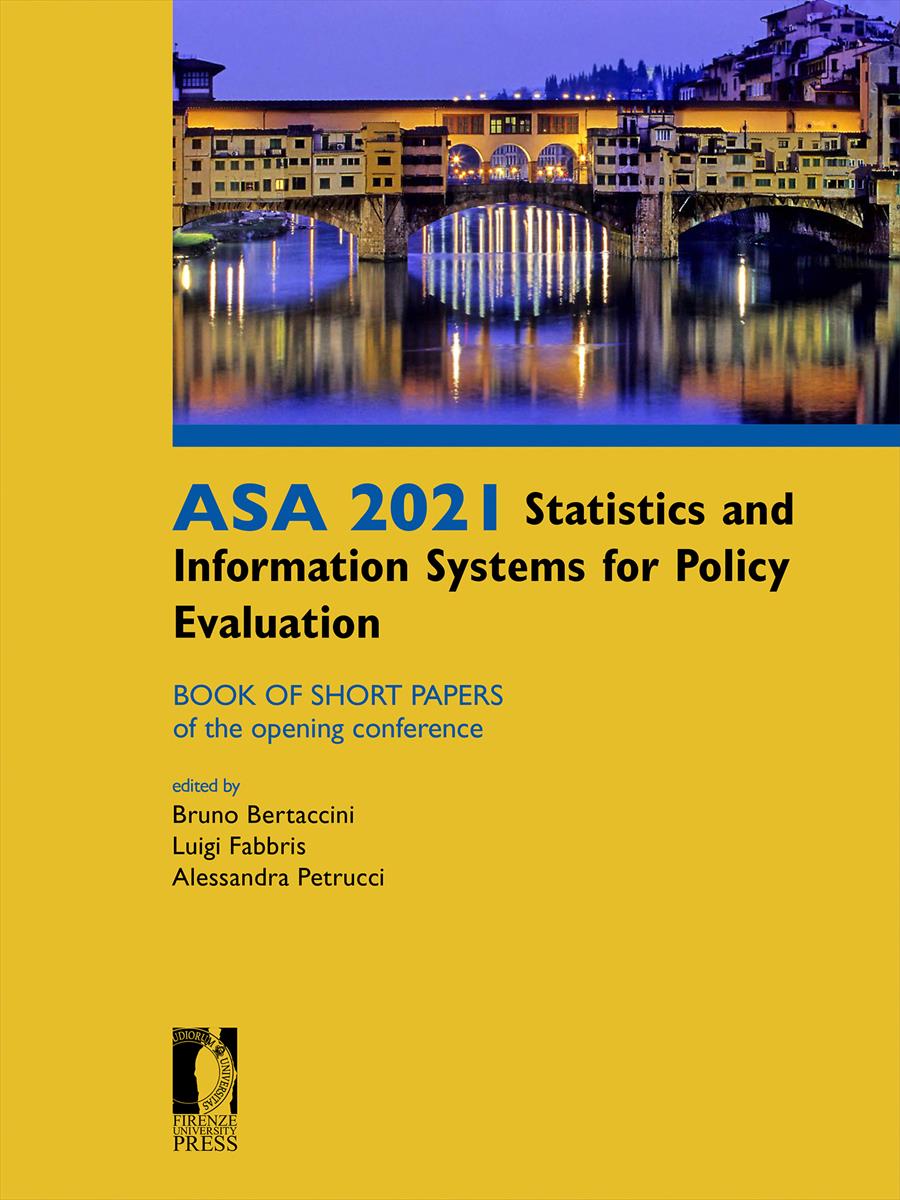- ASA 2021 Statistics and Information Systems for Policy Evaluation
- Edited by Bruno Bertaccini, Luigi Fabbris, Alessandra Petrucci
Frameworks and inequalities in healthcare: some applications
- Pietro Renzi
- Alberto Franci
- © 2021 Author(s) |
- CC BY 4.0
- DOI: 10.36253/978-88-5518-304-8.23
Background Social determinants of health (SDOH) have increasingly entered health policy conversations as a growing body of researches, reveal the direct relationship between social determinants and health outcome. In fact, the recent literature is moving from the traditional model that focus on how health affects economic status, to a new view that economic status affects health. Objectives To investigate the principal conceptual frameworks for action on social determinants of health. Another aim is to contribute on the ongoing discourse on feasible measures which could be used to alert regions to inequalities in the distribution of health. Methodology, Italian data are used as a demonstration. Quadrant charts illustrate associations between how much regions spend on health and how effectively health system functions. The relevant inequality measures are used to rank health inequalities. Main results Frameworks have been presented to help communities, health professionals and others begin to better understand and address a variety of factors that affects health. Quadrant analysis technique shows the extent to which spending more on health, translates into better health outcomes, higher quality of care and improve access to care across the Italian regions, whilst also recognition the importance of major risk factors. Conclusions The social inequalities in health and what this means for how we understand and reduce them, as not to date been compressively examined empirically. There is an urgent need to expand our knowledge with comparable data on health determinants and more refined health outcomes. Furthermore, there is a need for feasible inequality measures in the health information systems. The measures used in this study, provide a step to inform and guide the uptake of equity-sensitive policies.
- Keywords:
- Health inequalities,
- Frameworks of SDOH,
- Quadrant analysis,
- Inequality measures,
University of San Marino, Italy - ORCID: 0000-0001-6200-7265
University of Urbino Carlo Bo, Italy - ORCID: 0000-0002-8157-9792
- Bambra, C., Riordan, R., Ford, J., Matthews, F., (2020), The COVID-19 pandemic and health inequalities, J Epidemiol Community Health,74, pp. 964-968.
- Biggeri, A., Grisotto, L., (2009), Fonti di distorsione nelle misure delle disuguaglianze di salute, in Disuguaglianze sociali di salute. Problemi di definizione e di misura., eds. Costa, G., Cislaghi, C., Caranci, N., Salute e Società, Franco Angeli Editore, Milano, (I), pp. 78-89.
- Bruno, S., Sgritta, G. B., Trivellato, U., Zuliani, A., (1978), Stratificazione economico-sociale e distorsioni distributive nei servizi pubblici, in Atti della XXIX° riunione scientifica della Società Italiana di Statistica, Bologna 20-22/03/1978, CLEUP, Padova, (I), I/1 pp. 251-295
- Canadian council on social determinants of health (2015), A Review of Frameworks on the Determinants of Health, http://ccsdh.ca/images/uploads/Frameworks_Report_English.pdf.
- Fabbris, L., (1990), Analisi esplorativa dei dati multidimensionali, CLEUP, Padova, (I).
- Feinstein, L., Sabates, R., Anderson, T. M., Sorhaindo, A., Hammond, C., (2006), What are the effects of education on health? in Proceedings of the Copenhagen Symposium Measuring the Effects of Education on Health and Civic Engagement, eds. Desjardins, R., Schuller T., OECD/CERI, Copenhagen (DK), pp. 171-354.
- Fuller, M. F., Lury, D. A., (1977), Statistics Workbook for Social Science Students, Philip Allan Publishers Ltd, London, (UK).
- Kakwani, N., Wagstaff, A., van Doorslaer, E., (1997), Socioeconomic inequalities in health: measurement, computation, and statistical inference. J. Econom., 77(1), pp. 87-103.
- Marmot, M., Allen, J., Boyce, T., Goldblatt, G., Morrison, J., (2020), Health equity in England: The Marmot review 10 years on, The Health Foundation, London, (UK).
- National Academies of Sciences, Engineering, and Medicine, (2017), Communities in Action: Pathways to Health Equity. The National Academies Press, Washington DC (USA)
- O'Donnell, O., van Doorslaer, E., Wagstaff, A., Lindelow, M., (2008), Analyzing Health Equity Using Household Survey Data: A Guide to Techniques and Their Implementation, World Bank, Washington, DC (USA).
- OECD, (2019), Health at a Glance 2019: OECD Indicators, OECD Publishing, Paris, (F).
- Remington, P. L., Catlin, B. B., Gennuso, K. P., (2015), The County Health Rankings: rationale and methods, Population Health Metrics, 13
- Townsend, P., Davidson, N., (1982), Inequalities in Health: The Black Report, Penguin, London (UK) Vian, F., (1982), Analisi statistica degli squilibri territoriali in Le statistiche dello sviluppo. Atti del Convegno (Salerno, 15-16-17 ottobre 1980), Edizioni Scientifiche Italiane, Napoli, (I), pp. 463-477 Zajacova, A., Lawrence, E. M., (2018), The Relationship Between Education and Health: Reducing Disparities Through a Contextual Approach, Annual Review of Public Health, 39(1), pp. 273-289.
Chapter Information
Chapter Title
Frameworks and inequalities in healthcare: some applications
Authors
Pietro Renzi, Alberto Franci
Language
English
DOI
10.36253/978-88-5518-304-8.23
Peer Reviewed
Publication Year
2021
Copyright Information
© 2021 Author(s)
Content License
Metadata License
Bibliographic Information
Book Title
ASA 2021 Statistics and Information Systems for Policy Evaluation
Book Subtitle
Book of short papers of the opening conference
Editors
Bruno Bertaccini, Luigi Fabbris, Alessandra Petrucci
Peer Reviewed
Publication Year
2021
Copyright Information
© 2021 Author(s)
Content License
Metadata License
Publisher Name
Firenze University Press
DOI
10.36253/978-88-5518-304-8
eISBN (pdf)
978-88-5518-304-8
eISBN (xml)
978-88-5518-305-5
Series Title
Proceedings e report
Series ISSN
2704-601X
Series E-ISSN
2704-5846
